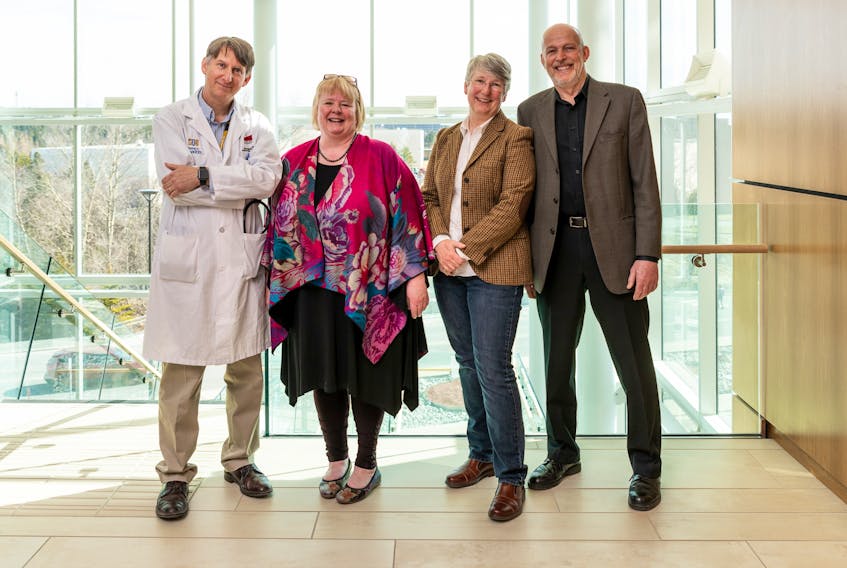Four researchers at Memorial University will accept a Governor General’s Innovation Award (GGIA) in Ottawa Wednesday for groundbreaking work they’ve done over 20 years to identify a lethal gene mutation that causes sudden cardiac death, dubbed the “Newfoundland curse.”
The GGIAs are given to individuals, teams or organizations whose innovations are exceptional, transformative and have a positive impact on quality of life in Canada, and the team made up of researchers and doctors Sean Connors, Kathleen Hodgkinson, Terry-Lynn Young and Daryl Pullman did just that — their work is literally saving the lives of those affected by a deadly genetic disease.
“This is a really devastating condition,” said Pullman. “It affects males much more, and we still don’t know why males are affected differently than women because females can have this gene and they are affected by it, but not nearly as severely as males.”
The team worked collaboratively on the discovery, treatment and legislative changes that came about as a result of their research.
“Discovering the gene is great, but to be able to bring that back to the families and to give them some answers, I mean that’s kind of the thing that validated the whole thing for me.” — Dr. Sean Connors
Essentially, they’ve added an average of 31 years to the lifespan of a person with the cardiac muscle disorder called arrhythmogenic right ventricular cardiomyopathy (ARVC), which occurs as a result of the gene mutation.
In this province, about one person out of every 700 has the cardiac disease-causing gene TMEM43. That’s a high percentage compared to a global average of about one in 5,000.
The genetic mutation is found in clusters, particularly in certain areas of the province, such as Brookfield, Port de Grave, Conception Bay South, and Corner Brook.
Prior to the team’s discovery and work to establish treatment, young healthy men in their 20s would inexplicably die suddenly of cardiac arrest.
Fifty per cent of males who have the mutation, if it’s left undetected and untreated, will die by the age of 40. Eighty per cent will be dead by the age of 50.
Before the team made their groundbreaking discovery, families around the province were left wondering what was causing their young healthy men to die so suddenly.
“Many young men in the prime of life in their 20s would just drop dead. In fact, I think just shortly before I came here, there was a graduate student … he was up in front of the classroom at the blackboard and it’s just like somebody throws a switch and the heart stops — and he just dropped,” said Pullman.
“The first symptom is you just die — it’s tragic,” added Connors.
Simple blood test saves lives
Thankfully, once the team discovered TMEM43, they were able to do a blood test to check for the mutation, and they developed preventive care by implanting defibrillators in those who have the mutation.
Thanks to their work, doctors around the world can now do the same blood test to check for the gene and if it shows up, they also know how to treat it.
So far, the team has tested about a thousand people in the province for the mutation and have installed about 300 defibrillators — mostly in young men in their 20s.
That effort is largely because the team reached out to families who were aware the Newfoundland curse was in their family because they had young men die. The team asked other people in the families to come in and get tested.
“Then we’ve got to talk to the young, healthy, 25-year-old man and say, ‘You need this done.’ And he’s probably never been in a hospital in his life. So, they’ve been challenging discussions,” said Connors.
People from around the world are interested in what the MUN research team has done, specifically because if someone has the identified gene, it automatically determines treatment.
“There’s no other example in all of cardiology where, based on a genetic test, you’re going to get a treatment,” said Connors.
The nature of the founder population in Newfoundland — which occurs when a new population is established by a small number of individuals — was helpful in identifying the gene, but since its discovery, doctors in Denmark, Norway, and Germany in particular have also noticed it in blood tests.
“They discovered in Germany there were some men going for heart transplants, and they looked at just the DNA of the heart, and they discovered the mutation that we had seen in Newfoundland in Germany — and more, they discovered that they could tell that they were related somehow to the people from Newfoundland,” said Connors.
“We could also tell that, based on the DNA, this mutation probably went back to around AD 800. … If you think about it as a disease in which half the offspring get it, and it’s been around for over a thousand years, there must be so many more people around the world that are affected by this.”
The researchers are humble about the Governor General’s Innovation Award, saying they represent a larger group of people who were involved with the research over the past two decades.
“It’s very gratifying and humbling to be part of this team,” said Pullman.
Connors said for him it’s been about his patients from the get-go.
He said for a long time there was a big question mark on some of these patients’ charts, and that throughout the 1980s doctors wondered what was going on to cause young men to suddenly die of cardiac arrest without any prior symptoms.
“We didn’t know the depth or the breadth of the problem, but we kind of got stuck into it, so it’s been a 20-year journey,” said Connors.
“Discovering the gene is great, but to be able to bring that back to the families and to give them some answers, I mean that’s kind of the thing that validated the whole thing for me.”
Research still ongoing
Despite the huge strides they’ve made, Connors said the team is still trying to “corner the gene and trying to fully understand it.”
“We still have unanswered questions. Most women with this gene die of old age, half of men die by the time they get to 40 — why is that? I have no idea why that is. What other genes might you have that could be protective or make this worse?”
Connors also recognizes there are technological advances that could mean people with the mutation might have other options besides getting a defibrillator.
The team also discovered the counter-intuitive role that exercise plays in exacerbating problems in people with the gene.
“I noticed that there were some young women who were quite athletic. … With this gene, they ended up having it much more malignant than I would expect for a woman. They were having their heart stop, they were having all kinds of trouble in their 20s.”
He said the added strain on the hearts of athletes from an early age causes the gene to “make itself known and starts to affect your heart much more aggressively.”
He said they’ve had to tell young people who may have dreams to run the Boston Marathon that they simply can’t do that because too much exercise for people with this gene can be damaging.
Genetic research ethics
Pullman’s role on the team involved convincing the provincial government to put legislation in place to protect people in this province who, because of the unique founder population here, are of particular interest to researchers and could be exploited.
“We’ve got a research ethics regime in this province to ensure that the research that’s done here is going to benefit the people here,” he said, noting that if they hadn’t considered the research ethics oversight perspective, they likely wouldn’t have gained access to data that was gathered by researchers in the United States and brought back to that country — not used to the direct benefit of the very people who participated in the studies.
While Canadian genetic researchers follow the Tri-Counsel Policy Statement, a major document for ethics oversight, Newfoundland is the only province where those guidelines are the law.
That legislative victory was thanks largely to Pullman’s efforts.
“We expected that given that we’ve moved into kind of the genetics era in medicine, that there were going to be more and more people that would want to come here to do research, and we’re not opposed to people coming here to do research … we’re happy to have people come from outside and work with us … but if you’re using the Newfoundland genome in order to make that possible, we want to make sure that the benefits, at least some of the benefits, are going to come back to the people of Newfoundland as well.”
Connors said the team’s work in discovering that a mutation in the novel gene TMEM43 was causing sudden cardiac arrest shows that genetic research can be done in this province successfully.
“Unlike all the noise that you hear in the media recently about these genetics companies that say, ‘We can’t work with Newfoundland, they’re not interested in having anything done’… fantastic work gets done.”
“We’re leading the country in terms of our apparatus to review studies (and) make sure that they’re correct. At the end of the day, you’re trying to protect the patients and the people of the province.”
Twitter: juanitamercer_









